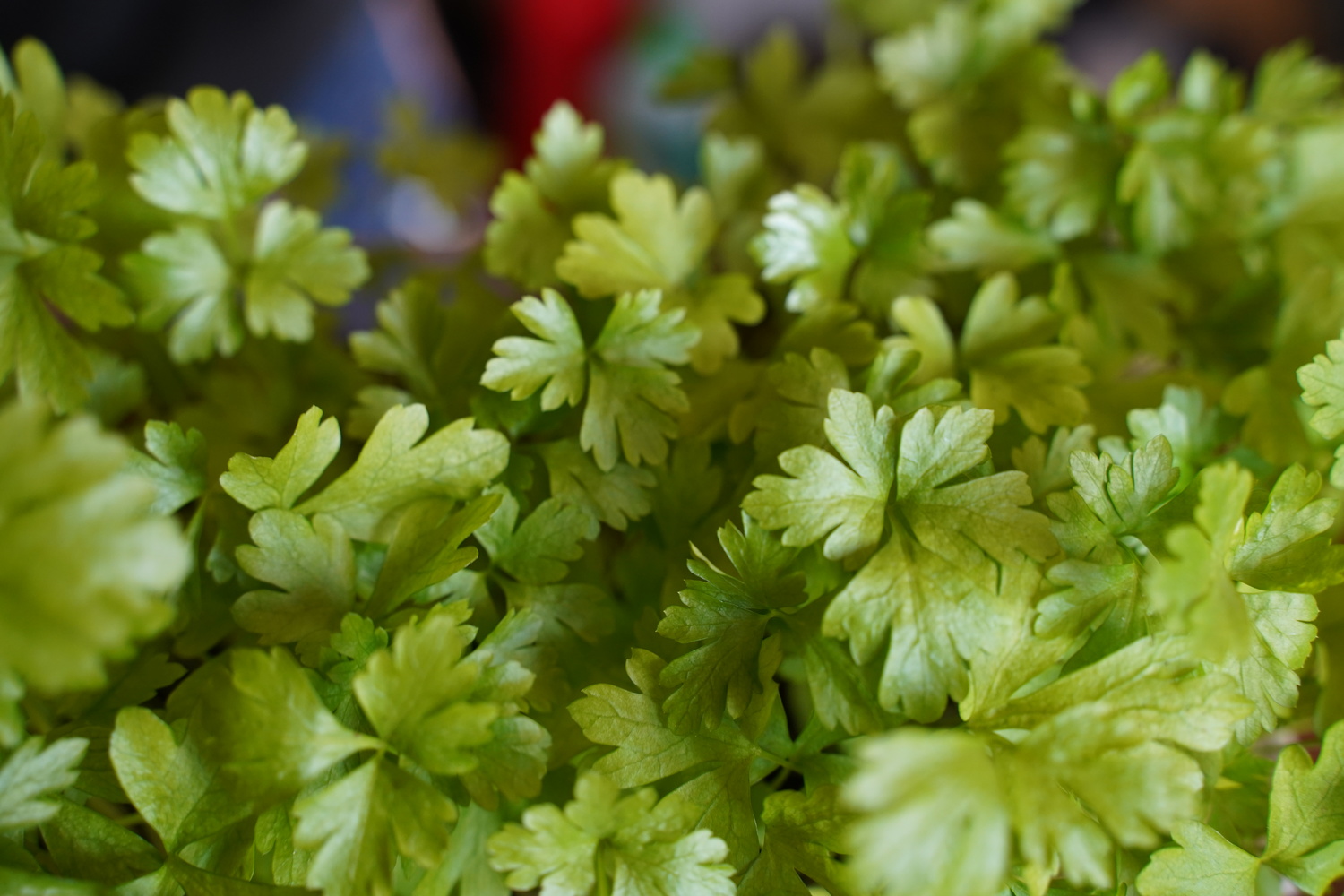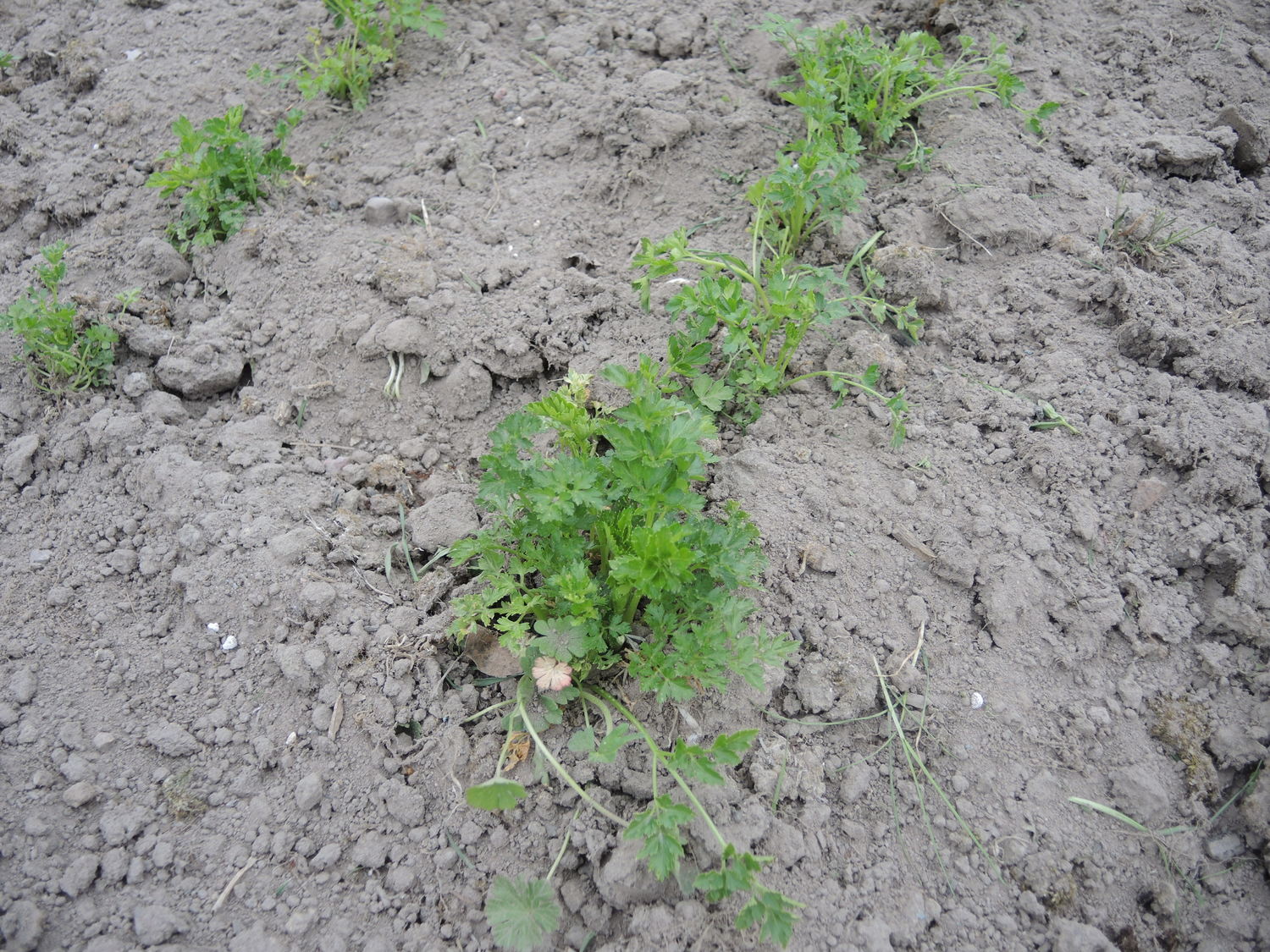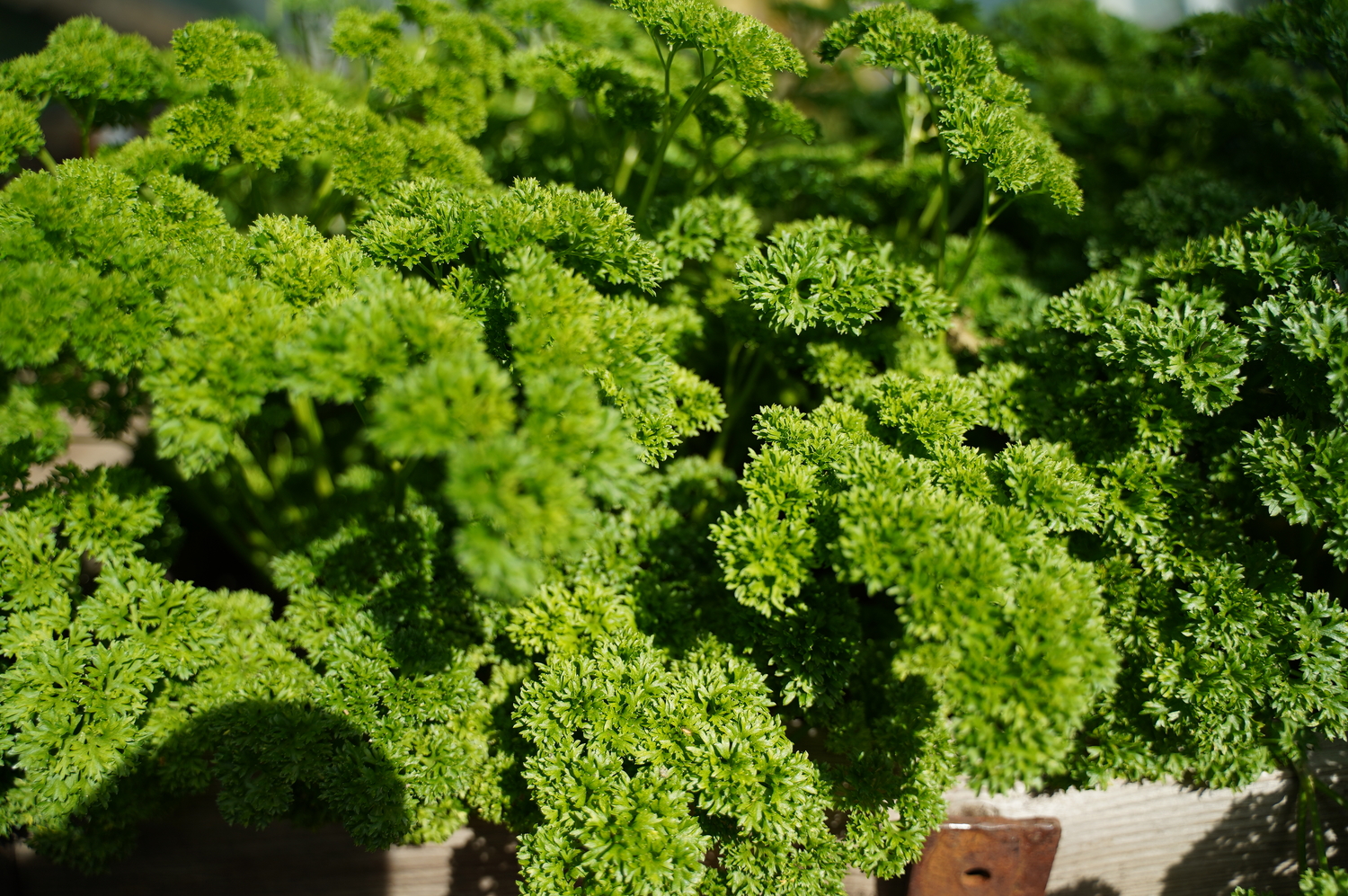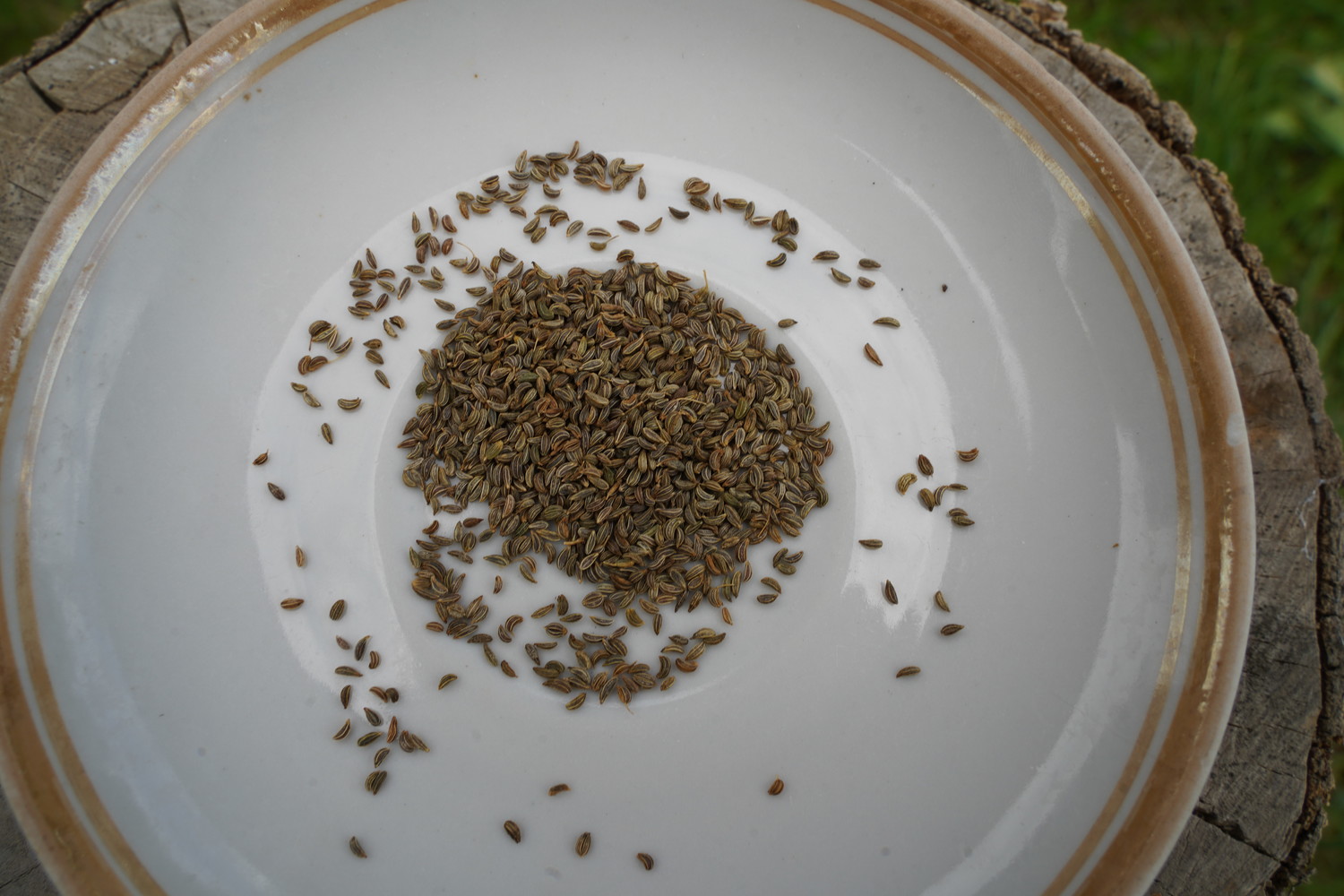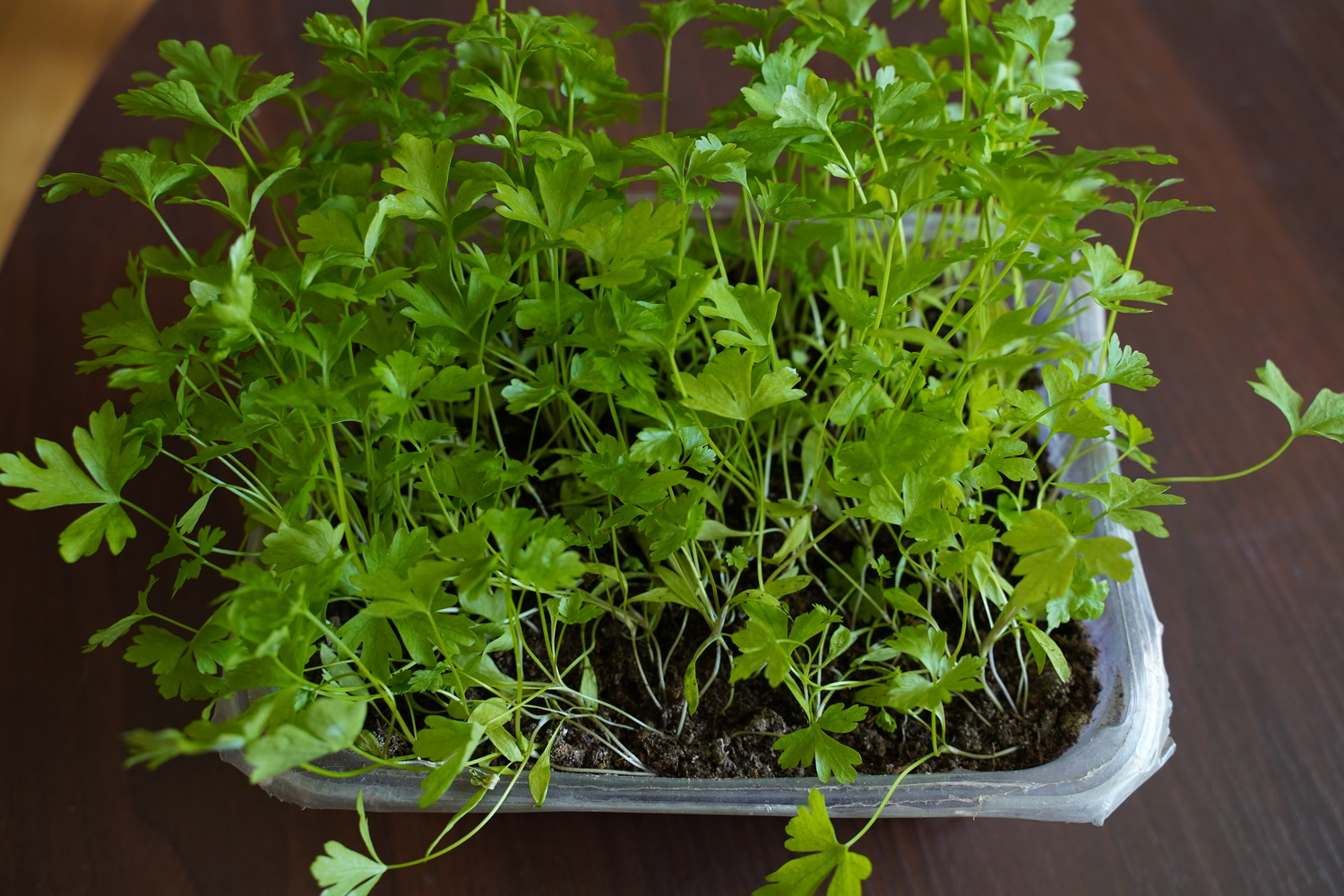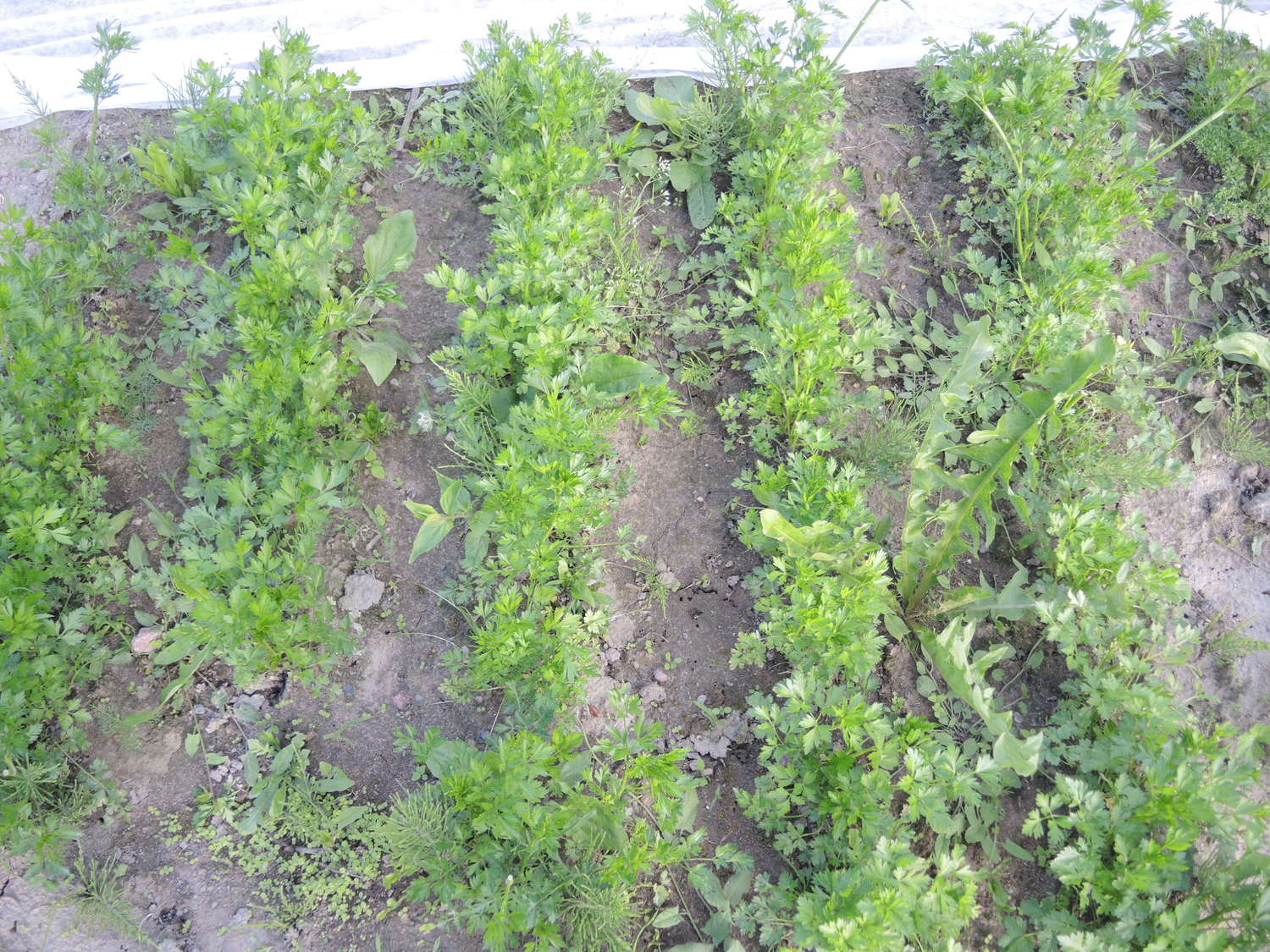Parsley is a biennial herbaceous plant from the Apiaceae (celery) family, grown either for its leaves or roots. Native to the Mediterranean region, parsley is now one of the most popular culinary herbs worldwide. It is widely used in cooking, pharmaceuticals, and cosmetics. Parsley is rich in essential oils, which give it its distinct aroma. The leaves contain up to 10 mg% of carotene (provitamin A), while the roots contain 35–64 mg% of vitamin C. Just 50 grams of parsley provide the recommended daily intake of both vitamin C and carotene. Additionally, parsley is a valuable source of B1, B2, K, and PP (niacin) vitamins, as well as potassium, magnesium, calcium, and phosphorus.
Leaf Parsley
Leaf parsley is a biennial herbaceous plant with dark green, aromatic leaves that can be either smooth or curly. It produces a lush foliage canopy, while its roots remain thin and branched. The pleasant aroma and flavor come from the essential oils found in the leaves.
Parsley contains proteins, carbohydrates, and folic acid, which has a beneficial effect on blood formation. Both fresh and dried parsley are commonly used to season soups, hot dishes and for preserving cucumbers, tomatoes, and mushrooms. Young leaves are often added to salads.
In traditional medicine, parsley leaves and seeds are used to stimulate appetite and support kidney and bladder health. Crushed leaves can be applied to bruises and wounds, while seed infusions are known to aid digestion.
Parsley Root
Root parsley is also a biennial plant, which produces tubers resembling carrots in the first year. It is not recommended to harvest the leaves of root parsley, as doing so can negatively affect the quality of the tuber. The roots are thick, white, smooth or slightly branched, while the leaves are smooth and finely cut. The flavor of the roots is reminiscent of celery.
Parsley root is used the same way as other root vegetables, such as carrots and parsnips. It has long been popular as a winter vegetable in countries like the Netherlands, Germany, and Poland. This is reflected in its various regional names, such as Hamburg parsley or Dutch parsley.
Parsley's raw material consists of roots, fruits, and leaves. The roots are harvested in the spring of the second year of growth. The soil is removed from the parsley roots, then they are washed, cut lengthwise, and dried. The parsley fruits are harvested in the summer from biennial plants when most of the seeds have ripened. The umbels are cut and spread on cloth for drying in a shaded, well-ventilated room. The parsley fruits are fully ripened, threshed, and dried.
Soil Preparation for Parsley Growing
Parsley is grown in light and medium loamy soils, which are well-cultivated, humus-rich, free of weeds, and have good drainage. The soil should not be acidic – parsley grows best in neutral pH soil, ranging from 6.1 to 7. Proper soil preparation is crucial for parsley yields. Well-prepared soil improves its structure, eliminates weeds, conserves moisture, and creates favorable conditions for microorganisms. It is essential to choose a field free from nematodes to successfully grow parsley. Growing parsley after plants that are hosts to nematodes is particularly risky, as their population, especially in light soils, can increase to the point where cultivation becomes unprofitable. The most dangerous crops to grow after parsley are celery, onions, and leeks.
In the parsley furrows, radish seeds are sown every 20 centimeters, which allows for precise visibility of the parsley row. Using a hoeing tool, the between-row areas are regularly loosened to eliminate emerging weeds. After sowing the parsley, the soil surface is slightly compacted, which further reduces clumping.
For parsley cultivation, the soil should be plowed in the fall. The start of spring soil preparation depends on the soil moisture level. Light soils can be worked when they are slightly wetter, as their clods crumble when dried. Heavier soils should be at normal moisture levels so they crumble well without sticking to the equipment. Before sowing, the soil must be deeply and loosely worked and rolled. It is crucial to avoid soils that form a crust on the surface after heavy rainfall, as this can hinder seedling emergence. The rule for sowing parsley is that it should be sown on the same day the soil is prepared. If you plan to plant a large area and cannot seed it all in one day, it is recommended to divide the area into smaller plots and prepare and sow one plot per day.
Parsley Fertilisation
The soil for parsley is prepared in the fall, and mineral phosphorus and potassium fertilisers are applied then. It is best to fertilise before plowing the soil. Fall fertilisation should be balanced properly by determining the amount of mineral nitrogen in the 0-60 cm soil layer. When plants are fertilised imbalanced or at the wrong time, it causes stress and disrupts their nutrition. In such cases, plants use stored organic materials to maintain their vital functions, which could otherwise be used to promote plant productivity, resulting in reduced disease resistance.
To grow a good yield of herbaceous or root parsley, 90-120 kg/ha of nitrogen (N), 50-70 kg/ha of phosphorus (P2O5), and 200-250 kg/ha of potassium (K2O) are needed. Hobby gardeners should reduce these fertiliser amounts by 20-30% for their plots. Phosphorus and potassium fertilisers, along with half of the nitrogen dosage, should be incorporated into the soil before sowing, so it is best to use complex fertilisers. In light soils, magnesium and micronutrients are very important and should be included in the composition of complex fertilisers. Foliar feeding with micronutrients also yields good results.
When growing parsley, fertilisation is done in such a way that nutrients are used efficiently and the environment is not polluted. The amounts of mineral fertilisers are calculated based on the expected average yield for the specific soil zone, the level of organic or green manure fertilisation, the nutrients left by preceding crops, their fertilisation, and the soil’s nutrient supply. It is important to remember that each plant uses nutrients from all sources differently.
Sowing Parsley
Parsley seeds are tiny, so special attention must be paid to planting accuracy. Sowed densely, parsley roots will grow small, resulting in non-standard products. The recommended distance between rows is 67-75 cm, with two rows in each bed spaced 6-8 cm apart. The planting depth is about 1 cm. A precise seed drill should be used for sowing. It is crucial not to delay sowing, as the plant's vegetation lasts 150-160 days. However, sowing too early in insufficiently warmed soil may extend the seed germination time and increase the risk of poor and uneven germination. Sowing is done at the end of April, but parsley can also be sown in the fall—at the end of October or in November. Parsley seedlings are frost-tolerant and can withstand temperatures as low as minus 9°C.
Parsley seeds should be sown into freshly prepared furrows, preferably on a cloudy day. The soil should be slightly moist. When planning to grow root parsley, it's important to remember that the length and uniformity of the root vegetables primarily depend on the depth of soil loosening and thorough breaking up of clumps. Agricultural machinery vendors in Lithuania offer precision seeders designed for sowing sprouted vegetable seeds. Parsley sown in this way germinates much earlier (about 7 days after sowing), the plants are uniform, and the yield is more abundant and of better quality. Additionally, the seed rate can be reduced by about 10%.
Parsley can be transplanted as seedlings, which results in a much earlier harvest. Another advantage of transplanting seedlings is avoiding competition with weeds during the germination phase. Parsley that grows from seeds in the field is often overtaken by faster-growing weeds. Weeding parsley is quite difficult.
Parsley Care
In the crops, weeds need to be regularly removed and not allowed to grow more than 1-2 true leaves, as later, higher doses of herbicides will be required, and the cost of weed control will be significantly higher. Once parsley has germinated, the rows should be loosened to prevent weeds from taking over. Parsley is very sensitive to moisture. During the first month, for the plants to properly absorb nutrients and grow normally, they require a lot of moisture. If there is no rain, parsley must be watered. Watering should be light but frequent. Parsley grows poorly in waterlogged soil. When the roots of root parsley reach 1.5-2 cm in diameter, less moisture is required, but if it is scorched, the roots may crack. To protect against fungal diseases, it is best to water parsley early in the morning.
Parsley can be covered for the winter to ensure fresh greens early in the spring.
Harvesting Parsley
The raw material for parsley includes roots, fruits, and leaves. The roots are harvested in the second year of growth. Root parsley is harvested similarly to carrots, but its roots dry out faster, so they cannot be left on the soil surface for long. The roots should be stored like carrots in a cellar.
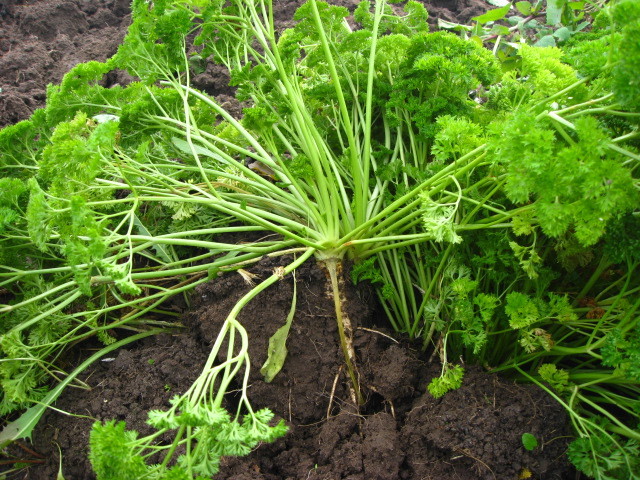
For quick use, leafy parsley is harvested when 5-6 true leaves have formed. The leaves can be harvested continuously, and in autumn, when the leaves reach 15-20 cm. For longer storage, parsley leaves and roots can be dried, frozen, or preserved.
Pests and Diseases of Parsley
Parsley septoria is a disease that affects parsley and parsnips. Irregular, dirty white or brown spots with dark brown borders appear on the leaves, petioles, and flower stems, which become lighter. On the upper side of the leaves, small, 100 μm in diameter, thin-walled dark brown spots, in the form of fungal fruiting bodies (pycnidia), can be seen.
Protection measures: After harvesting the parsley crop, it is essential to destroy all crop residues, plow or bury the soil deeply, and follow crop rotation practices. Only healthy, chemically or thermally disinfected seeds should be sown. Seedbeds can be sprayed with a registered fungicide.
The celery leaf mining fly damages celery, parsley, parsnips, and many other plants from the Apiaceae family. On parsley leaves, large, flat, irregularly shaped spots—mines—are visible. Initially, these mines are white, later turning brown. When viewed against the light, the damaging larvae and their small black droppings are visible inside the mines. More severely damaged leaves turn yellow and later dry out.
Protection measures: In small plots, it is necessary to collect the damaged mined leaves and bury them deeply or burn them. Crop rotation should be followed. In the fall, deeply plow or dig the soil and destroy plant residues. Around Apiaceae plantings, it is important to remove weeds from the celery family.
The carrot fly affects carrots, root parsley, parsnips, and occasionally celery and other Apiaceae family. Damaged plants become stunted, weak; their leaves turn a violet hue, then yellow, and they dry out. The larvae of the flies burrow into the tops of young roots, and in larger roots, they can penetrate as deep as the core.
Protection measures against this pest are similar to those for other pests: follow crop rotation, plow the soil deeply in the fall, and control weeds. Seed treatment (seed dressing) can protect against the first generation of fly larvae. Parsley should be sown as early as possible in drier, open areas, and the crops should be thinned on time.

